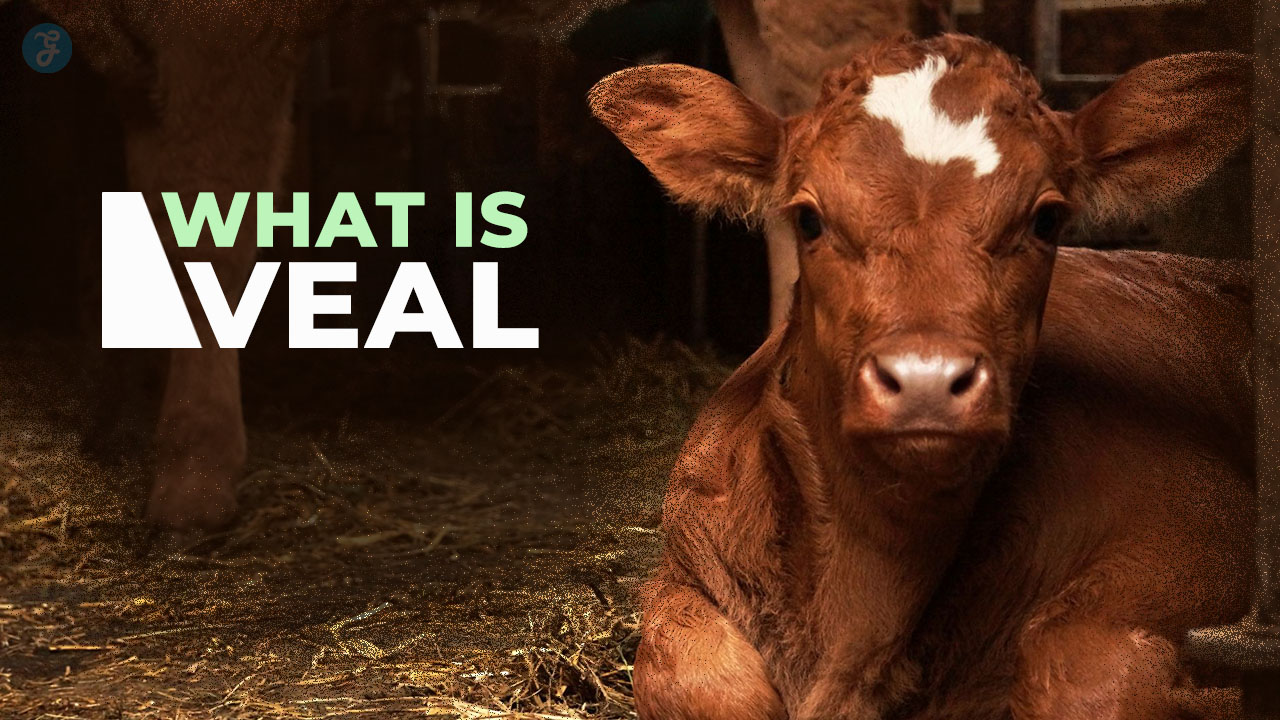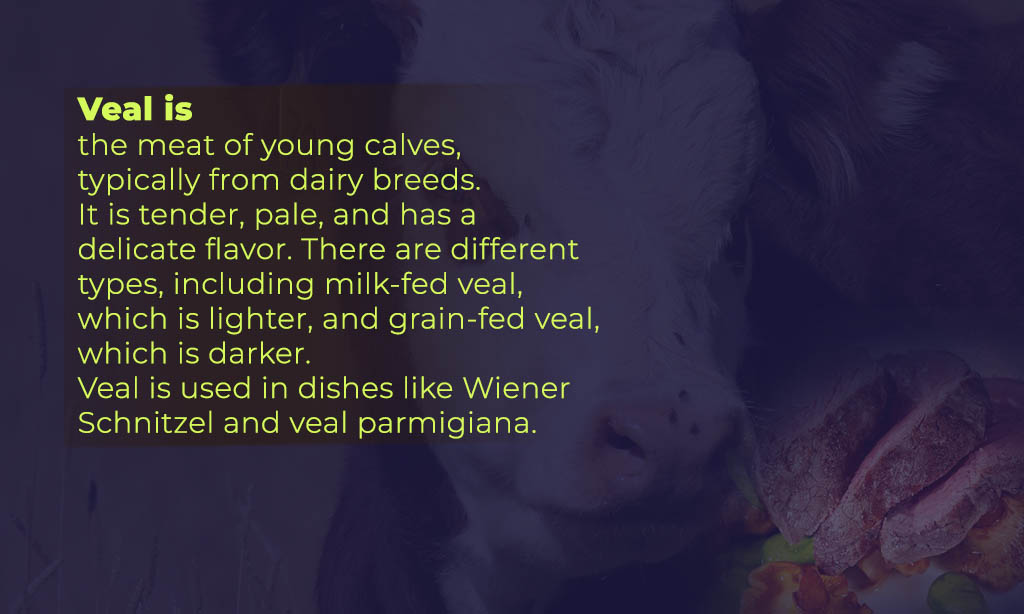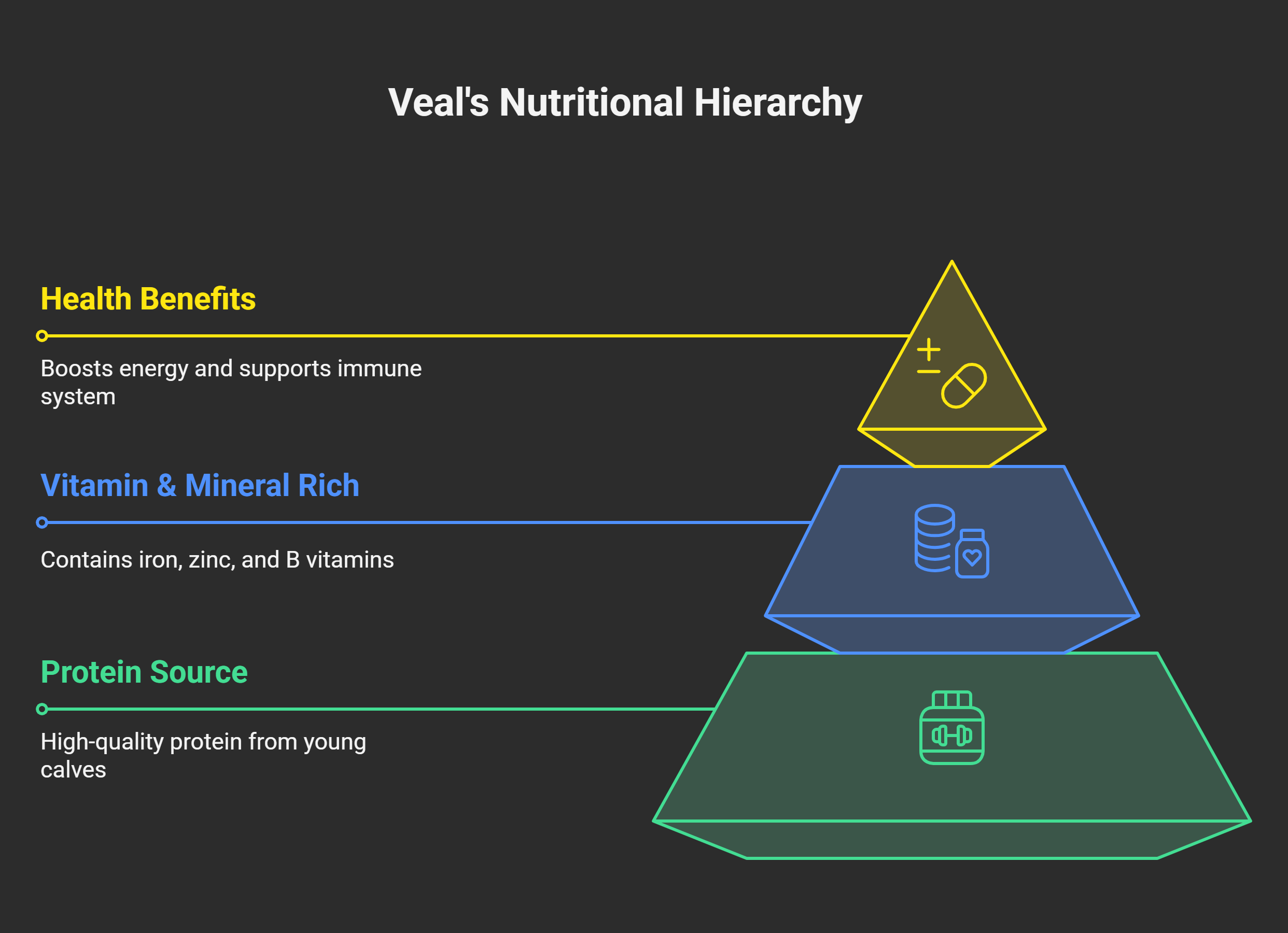You see veal on menus, but you don’t know what is veal. You know beef well, but calf meat feels like a mystery. You might worry about animal welfare or veal crates on farms.
Veal is meat from young calves, not older cattle. This post explains the difference between beef and veal, shows types like milk-fed, rose veal, and bob veal, and gives cooking tips plus nutrition facts.
Read on.
Key Takeaways
- Veal is meat from calves under 20 weeks old, per the USDA, and farms feed them milk formula and whey to control diet and health.
- Milk-fed calves reach 200–230 kg by 20–24 weeks and yield ivory-pink meat; grain-fed calves reach 290–320 kg by 22–26 weeks and yield darker, marbled meat.
- Rose veal calves live 35 weeks in roomy pens with vitamins and limited antibiotics for soft pink meat; bob veal calves face slaughter by 23 days old for very lean, pale meat.
- Veal packs lean protein, iron, zinc, and B vitamins, and chefs use it in dishes like Wiener schnitzel, osso buco, pan-seared cutlets, braised shanks, and rich stocks.
What Is Veal?
Veal means meat from calves, not from mature cows or bulls. The United States Department of Agriculture defines veal as flesh from young cattle under 20 weeks of age. Farmers rely on male dairy calves from dairy farms that the dairy industry does not use for breeding.
Producers refer to those as surplus calves.
Raising veal uses milk formula and whey solids from cheese plants. Workers keep calves in pens to control diet and health. They ship white veal at around 18 weeks of age. This process costs more per pound than beef from older cattle.
Types of Veal
Veal comes in a range of hues and flavors, and skilled cooks pair each type with the best method. A plain pan and kitchen gauge help them hit the right protein mark every time.
Milk-fed veal
Local ranchers feed veal calves fortified milk formula, not solid food. They raise male calves on a small veal farm, with fresh bedding and water. These calves grow slowly, and they reach 200 to 230 kilograms by 20 to 24 weeks.
Their ivory, creamy pink meat stays that color because they avoid grass or grains.
Chefs prize this meat for its mild flavor, and they use it in cutlet recipes or for slow roasting. Dairy farms send calves from dairy cattle herds to veal producers. Producers in the veal industry focus on animal health, clean water, and a controlled diet.
Next, we explore grain-fed veal.
Grain-fed veal
Many dairy cows give birth each year, so farms need homes for bull calves. Farmers put those calves into grain-fed veal production. They feed each veal calf a mix of grain, hay, and other solids.
This diet builds muscle, packs in iron, and shapes fat in the rumen. The meat comes out darker, with marbling that cooks well.
Producers send calves to slaughter at 22 to 26 weeks. Most reach 290 to 320 kg by then, that is 650 to 700 pounds. Veal meat from calves raised for veal offers a bolder taste than milk-fed veal calves.
Chefs slice it thin for wiener schnitzel or simmer it into a hearty stew.
Rose veal
Rose veal comes from calves raised under animal welfare standards. Farmers slaughter calves at 35 weeks, so the meat keeps a soft, pink hue. They house calves in roomy pens, blend their feed with minerals and vitamins, and work with veterinarians to limit antibiotic use.
Vets give penicillin or tetracycline only when disease or diarrhea strikes.
Butchers call it young beef or baby cow meat. Chefs sear sirloin steak, tenderloin, or chops in a hot skillet. Restaurants in Italy and France showcase it in parmigiana and scaloppine.
The flesh offers protein, iron, and B vitamins, with fewer calories than many beef cuts.
Bob veal
Farmers raise baby cows for bob veal under intensive animal farming. The calves enter the veal industry and face slaughter between two hours and 23 days old under strict animal slaughter rules.
Carcasses weigh 68.2 to 136 kg, about 150 to 300 lbs. Beef experts debate bob veal in dairy farming and beef cattle circles.
This meat appears pale and offers lean protein for diets low in fat. Chefs pick Bob veal for its silky texture in dishes like veal parmigiana. Critics question the ethics of using meat from baby cows in modern cuisine.
Nutritional Benefits of Veal
Veal gives lean protein and trace minerals to fuel muscles and build bones like a hero’s. It adds B-group vitamins and nutrients to stop fatigue and boost your energy.
High-quality protein source
Protein from young male dairy calves ranks high among red meats. Farmers feed milk to calves in the veal industry inside controlled barns; no hormone or drug touches the herd. Each serving packs iron, zinc, and other minerals to build strong bones and support the gut.
Diet plans from veal farmers Mix milk and grains for top protein yield. Controlled feeding helps calves grow lean muscle under stress-free care. Safe handling stops bacteria before they reach the bones.
Quick chills and proper cooking kill germs and seal in juicy flavor.
Rich in vitamins and minerals
This meat contains iron, zinc, and B vitamins. Special-fed veal calves get a diet with 40 essential nutrients from three weeks old. The American Veal Association promotes balanced feed plans.
Farmers in Canada and the United Kingdom use strict veal-raising practices.
Iron fights anemia by boosting hemoglobin in blood. Zinc supports immune cells and the gastrointestinal tract. B vitamins help convert food into energy. Lean veal loin cuts pack a punch of nutrient value.
Culinary Uses of Veal
Pan-seared veal cutlets taste tender and bright. You can flip slices in a frying pan with a spatula, spoon garlicky broth over them, or shred slow-braised shoulder with two forks for a cozy pasta sauce.
Popular veal dishes
These dishes show how veal comes from young calves born for tender, lean meat. They make veal dishes a hit in Italian, French, and Mediterranean kitchens.
- Cotoletta alla Milanese pairs a pounded cut of veal with crisp breadcrumbs; it fries in a warm skillet until golden.
- Wiener schnitzel uses milk-fed veal; chefs dredge it in flour, egg, and crumbs, and then they fry it until it pops with flavor.
- Blanquette de veau simmers rose veal in a stock of carrot, onion, bay leaf, and thyme; it yields a creamy French stew.
- Osso buco braises veal shanks in white wine, tomato, celery, and garlic; it yields rich marrow at the bone.
- Escalopes of veal slice lean meat thin; they cook in butter with lemon in a hot pan; they finish under the broiler for crisp edges.
- Roast a joint of veal, rub herbs, garlic, and oil into the joint, and the oven transforms it into a tender center with a golden crust.
Cooking methods for veal
After tasting popular veal dishes, you can explore cooking methods for veal. Proper techniques keep low-fat cuts tender, and roasted bones yield rich stock flavor.
- Pan-searing: Heat oil in a skillet over medium-high heat, sear cutlets on each side for 2 minutes, then let meat rest; this locks in moisture.
- Braising: Brown bob veal shanks from young calves, add broth, toss bones for mineral-rich liquid, and simmer 2 to 3 hours until meat falls off bone.
- Grilling: Thaw frozen food veal fully, brush with oil and salt, grill over medium heat, flip once, and slice against the grain.
- Poaching: Submerge scallops in seasoned stock at a gentle simmer and cook for 6 to 8 minutes; this keeps protein intact and yields tender slices.
- Stock-making: Roast bones, add water, onion, celery, and carrot, simmer 8 to 10 hours, strain offal bits, and use liquid for soups.
- Pan-frying offal: Slice calf liver or kidneys, pat dry, dust with flour, fry in butter until golden, serve with herbs.
Takeaways
Veal comes from young calves and packs a protein punch. Chefs love it for tender slices and quick recipe tweaks. It adds iron and zinc, two vital minerals, to your diet. Home cooks pan-sear soft veal cuts in a hot frying pan or bake them with herbs.
This versatile meat option shines in Italian cuisine or French escalope, bringing a delicate taste and easy prep. Every forkful proves that veal can fit a balanced diet and wow the palate.
FAQs on What is Veal
1. What is veal?
Veal is the meat from a young calf. It can come from either sex. Farmers raise calves for veal or beef. Some calves reach 150 pounds by 35 weeks of age.
2. Are veal crates banned?
Yes, many laws have banned veal crates. Now calves have more space to roam. This cuts stress and odd behavior.
3. What are common cuts of veal?
Common cuts of veal include cutlets, chops, and roasts. Well-cooked veal has a pale pink meat color and a mild taste.
4. Is veal cruel?
Some people say veal is cruel. They point to bob veal or slink veal. Bob veal is from calves at 3 weeks of age. Slink veal is made from stillborn calves.
5. What nutrients does veal provide?
Veal has protein and fat, plus iron, zinc, and other minerals. It fits in any diet plan. It helps infants and adults grow strong.
6. How do farmers care for veal calves?
Farmers feed milk that a mother would produce or a replacer. They watch stomach health and track weight gain. They add exercise and give extra space. They start weaning calves to solid feed in a few months. They use medication to prevent otitis media and to ease stress.











































